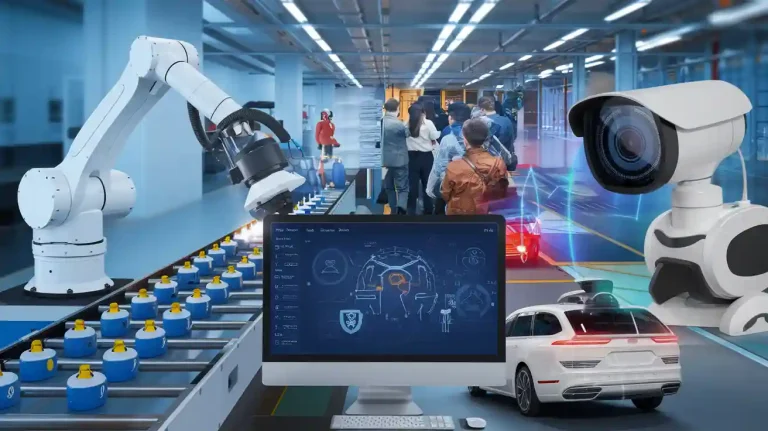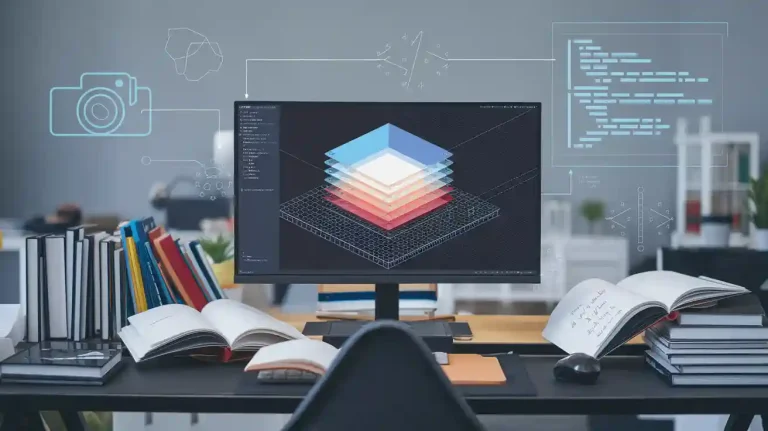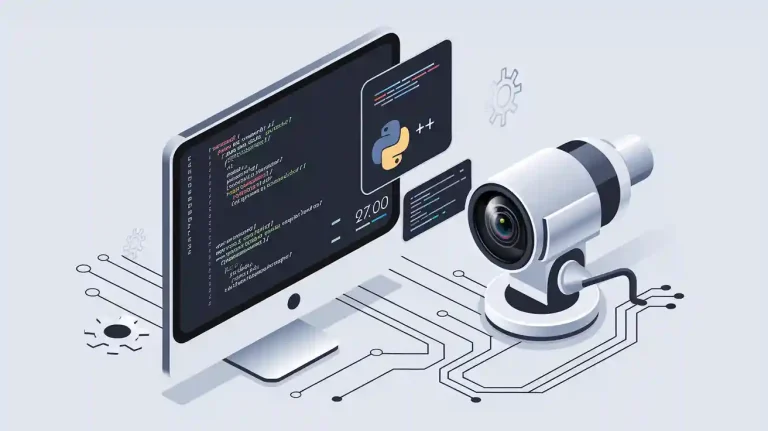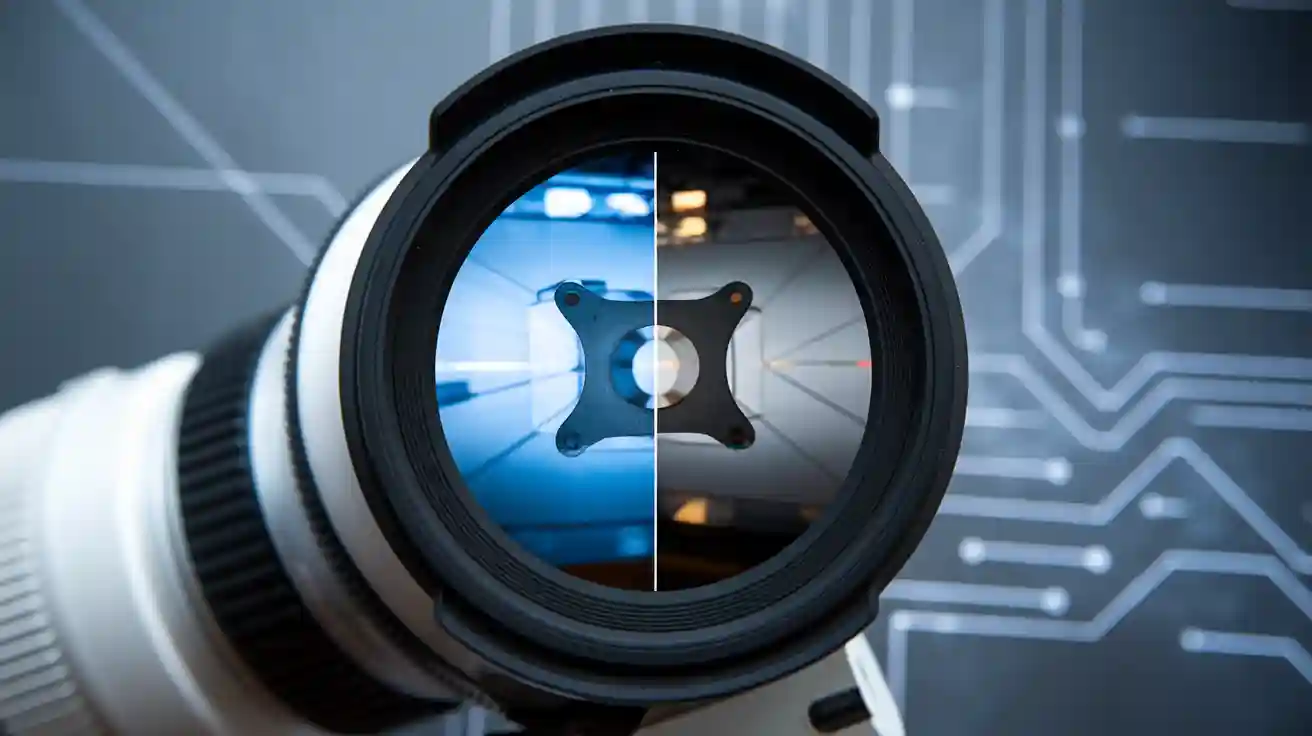
Image contrast plays a vital role in how a machine vision system performs in real-world environments. In machine vision applications, the system must detect, inspect, and measure features, and this process depends on clear differences in color and brightness. Think about reading text: bold letters stand out, but faded letters blend with the background. The same idea applies to image contrast machine vision system performance. When an ai-enabled machine vision system analyzes objects, color separation allows each feature to become visible. If color contrast drops, the system may miss key features or confuse shapes, especially when color backgrounds appear similar. Studies show that changing brightness and color can lower feature detection accuracy, even for advanced systems. For example, an image contrast machine vision system that adapts quickly to brightness and color changes can keep high accuracy, but less advanced systems may struggle. In machine vision applications, poor color contrast leads to errors in sorting, counting, or measuring. Color differences help the system find edges, match patterns, and recognize objects. Without enough color contrast, the system cannot deliver reliable results in machine vision applications.
Key Takeaways
- High image contrast helps machine vision systems detect and measure features accurately by making objects stand out from their backgrounds.
- Lighting, optics, sensors, and image processing work together to create and enhance contrast for reliable inspection results.
- Choosing the right lighting technique and filters can greatly improve contrast and reduce errors in detecting defects or sorting objects.
- Advanced sensors and image processing algorithms boost contrast and help systems perform well even in low-light or challenging environments.
- Careful system design, testing, and balancing contrast with resolution ensure consistent, accurate machine vision inspections.
Image Contrast in Machine Vision Systems
What Is Image Contrast?
Image contrast describes how much an object or feature stands out from its background in a visual scene. In technical terms, experts measure contrast using formulas like Weber contrast, Michelson contrast, and RMS contrast. These formulas compare the difference in luminance between an object and its surroundings to the average luminance. This measurement gives a precise way to determine how visible a feature is within an image. In an image contrast machine vision system, this visibility is crucial for detecting and extracting features. When the contrast is high, the system can easily separate objects from their backgrounds. When the contrast is low, features blend together, making detection difficult.
Note: In machine vision, contrast is not just about how an image looks to the human eye. It is a measurable property that directly affects how well a system can identify and analyze features.
Why Contrast Matters
Contrast plays a central role in every specific machine vision application. It defines the degree of color or grayscale difference between features in an image. High contrast images show clear variations in color or brightness, which helps objects stand out from their backgrounds and from each other. This separation is essential for tasks like inspection, sorting, and measurement. For example, in a pharmaceutical inspection system, a monochrome camera might struggle to distinguish between red and green gel capsules if the contrast is only 8.7%. This low contrast can lead to missed defects or incorrect sorting. By adding a green glass filter, the contrast can jump to 86.5%, making the capsules much easier for the system to tell apart. This improvement shows how increasing contrast can transform the reliability of an inspection process.
Machine vision systems often use contrast enhancement techniques, such as histogram equalization or CLAHE, to adjust pixel intensities and make features more visible. These techniques are especially important when lighting conditions are not ideal. In forensic inspection, for instance, enhancing contrast can make shoeprints clearer and edges sharper, allowing the system to extract more accurate information. Every specific machine vision application, from quality inspection to object recognition, depends on optimal contrast to ensure that features are detected and measured correctly.
Contrast and System Accuracy
The accuracy of an image contrast machine vision system depends heavily on contrast. Proper lighting increases contrast, which helps the system capture all necessary details and avoid shadows or reflections that could distort the image. High contrast improves the system’s ability to find edges and features, which is vital for defect detection and precise measurement during inspection. Consistent illumination and optimized lighting setups are essential because other system components cannot compensate for poor contrast.
- Proper lighting enhances image contrast, capturing all details and avoiding distortions.
- High contrast allows the system to distinguish edges and features, improving defect detection and measurement accuracy.
- Consistent lighting is essential for reliable inspection results.
- Studies show that changes in color contrast affect model accuracy and perception, proving that contrast is key to system performance.
- Calibration and proper lighting together ensure accurate object detection and positioning.
Different types of inspection rely on contrast in unique ways. Quality inspection uses high contrast to spot small defects or color inconsistencies that humans might miss. Object recognition needs enhanced contrast and good lighting to clearly see edges, textures, and colors. Monochrome cameras excel in dimension measurement when strong contrast is present, while color cameras detect subtle differences in brightness or hue for quality control. Image preprocessing steps, such as contrast enhancement and noise reduction, improve image quality before the system extracts features or recognizes patterns.
Tip: Always select lighting and lenses that maximize contrast for your specific machine vision application. This choice directly affects the accuracy and reliability of inspection results.
Four Cornerstones of Image Contrast
Image contrast in machine vision depends on four main factors: lighting, optics, sensor, and image processing. These four cornerstones of image contrast work together to help the system see differences between features, backgrounds, and colors. Each cornerstone plays a unique role in creating or enhancing contrast, which is essential for accurate inspection and reliable results. The importance of each cornerstone can change depending on the application, the type of object, and the inspection environment. For example, geometry and structure matter more for shiny surfaces, while color and filters are critical for transparent or colored objects. Understanding how these factors interact helps engineers design better systems for any inspection task.
Lighting
Lighting forms the foundation of image contrast in machine vision. The way light interacts with an object, known as object light interactions, determines how features appear in the image. Adjusting the spatial relationship among the camera, light, and object—called contrast changes via geometry—can highlight or hide certain features. For example, back lighting creates strong silhouettes, making it easier to detect the presence or absence of parts during inspection. Using different wavelengths, such as red or infrared, can improve contrast on colored backgrounds. For instance, reading black print on colored crayons becomes clearer under 850 nm near-infrared light than under white light. Lighting techniques like diffuse, bright field, and dark field each serve specific inspection needs. Diffuse lighting reduces glare on shiny surfaces, while dark field lighting highlights scratches or surface flaws. Filters can block unwanted light, such as ambient factory lighting, and enhance weak signals, like UV-induced fluorescence. The choice of lighting source—LED, fluorescent, or halogen—also affects contrast, especially when space or ambient light presents challenges.
Tip: Always match the lighting technique to the surface properties and inspection goals. Proper lighting can make the difference between a successful inspection and missed defects.
| Lighting Technique | Effect on Contrast and Application in Inspection |
|---|---|
| Back Lighting | Creates strong silhouettes for presence/absence detection and measuring objects. |
| Diffuse Lighting | Provides even light, reduces glare, and enhances curved or shiny surfaces. |
| Partial Bright Field | Uses directional light to show topographic detail but may cause hotspots on shiny surfaces. |
| Dark Field Lighting | Highlights surface imperfections by reflecting light from small defects, ideal for scratch or flaw detection. |
Optics
Optics, including lenses and filters, shape how the system captures and processes light. Lenses focus light onto the sensor, and their quality affects image sharpness and contrast. Filters play a key role in contrast changes via structure by blocking or passing specific wavelengths or directions of light. For example, infrared cut-off filters prevent unwanted IR light from degrading image quality, especially in color cameras. Neutral density filters control brightness without changing exposure, which is useful in high-intensity inspection environments. Polarizing filters reduce glare from shiny surfaces, making features clearer. A practical example involves sorting red and green gel capsules. Without a filter, a monochrome camera sees only 8.7% contrast between capsules, making inspection unreliable. Adding a green glass filter increases contrast to 86.5%, allowing accurate sorting. This shows that optical filters can boost contrast more cost-effectively than changing lighting or lenses.
Note: Selecting the right filter can dramatically improve contrast, especially when inspecting objects with similar colors or in challenging lighting conditions.
Sensor
The sensor converts light into digital signals, and its characteristics directly affect image contrast. Dynamic range measures how well the sensor captures both dark and bright areas in a single frame. A high dynamic range helps the system see details in scenes with strong lighting differences, such as inspecting reflective surfaces or reading labels in dim areas. Pixel size also matters. Larger pixels collect more light, increasing sensitivity and improving contrast, especially in low-light inspection tasks. Smaller pixels offer higher resolution but may lower sensitivity and contrast due to increased noise. Recent advances in sensor technology, like front-side and back-side illumination, allow sensors to capture high-resolution images even in low light. Event-based sensors, which mimic the human retina, detect changes in brightness rather than capturing full images at fixed intervals. This design improves contrast detection in fast-moving inspection scenes.
| Pixel Size | Sensitivity | Resolution | Typical Inspection Use Case |
|---|---|---|---|
| Large | High | Lower | Better contrast in low-light, general detection |
| Small | Lower | High | Fine detail inspection, but with more noise |
Image Processing
Image processing algorithms enhance contrast after the image is captured. Techniques like histogram equalization redistribute pixel intensities, making features stand out even when lighting is uneven. Adaptive histogram equalization works locally, improving contrast in specific regions of the image. These methods help the system see edges, textures, and color differences more clearly, which is vital for inspection accuracy. Advanced algorithms, including those based on deep learning, can adapt to complex real-world conditions. They improve contrast and visibility in low-light or high-glare situations, supporting tasks like defect detection and quality control. Filtering techniques reduce noise and sharpen edges, while super-resolution algorithms reconstruct fine details from low-resolution images. These enhancements allow machine vision systems to perform reliable inspection, even when the original image quality is poor.
Alert: Modern image processing not only improves contrast but also increases the reliability of automated inspection, especially in challenging environments.
Machine Vision Lighting
Lighting plays a pivotal role in creating and optimizing contrast in machine vision lighting. The right illumination techniques help features stand out, reduce noise, and make inspections more reliable. In industrial environments, lighting quality and consistency directly affect image clarity and contrast. Stable machine vision lighting ensures that critical features remain visible, while poor lighting can cause shadows, glare, and reflections that hide important details.
Lighting Techniques
Engineers use several standard methods in machine vision lighting to maximize contrast. Each technique serves a specific purpose based on the object’s surface and inspection needs. For example, backlighting creates strong silhouettes, making it easier to detect edges and measure objects. Bright field lighting shines light from above, enhancing contrast on flat surfaces. Dark field lighting uses low-angle light to highlight textures and surface flaws. Diffuse lighting spreads light evenly, reducing glare on shiny or curved surfaces. Multispectral illumination techniques, such as infrared or ultraviolet, reveal defects and material differences not visible in normal light. The table below summarizes these methods:
| Lighting Technique | Description | Effect on Contrast / Use Case |
|---|---|---|
| Backlighting | Light behind object | Maximizes contrast for edge detection |
| Bright Field | Light from above | Enhances contrast on flat surfaces |
| Dark Field | Low-angle side lighting | Highlights textures and flaws |
| Diffuse Lighting | Even light from all directions | Reduces glare on shiny/curved surfaces |
| Multispectral Lighting | Uses IR/UV beyond visible spectrum | Shows hidden defects and color differences |
Back Lighting
Back lighting stands out as a standard method in machine vision lighting for edge detection and feature separation. Placing the light source behind the object creates a bright background and a dark outline. This high contrast makes it easier for the system to find edges and measure parts accurately. Back lighting is especially useful for detecting holes, gaps, or missing pieces in transparent or opaque materials. It also supports contrast changes via color lighting, helping the system distinguish between objects of similar color.
Filters and Polarizers
Filters and polarizers further enhance contrast in machine vision lighting. Color filters allow only certain colors to pass, making features with specific color characteristics more visible. Infrared and ultraviolet filters reveal differences not seen in normal light. Polarizing filters remove glare from reflective or transparent surfaces, such as glass or water. Linear polarizers placed on both the light source and the lens can eliminate hot spots and increase contrast. Cross-polarization, where two polarizers are set at right angles, reduces reflections even more. These tools help the system see surface details clearly, even on shiny or transparent objects.
Tip: Consistent machine vision lighting and the right illumination techniques ensure accurate, repeatable inspections in any environment.
Measuring and Enhancing Image Contrast
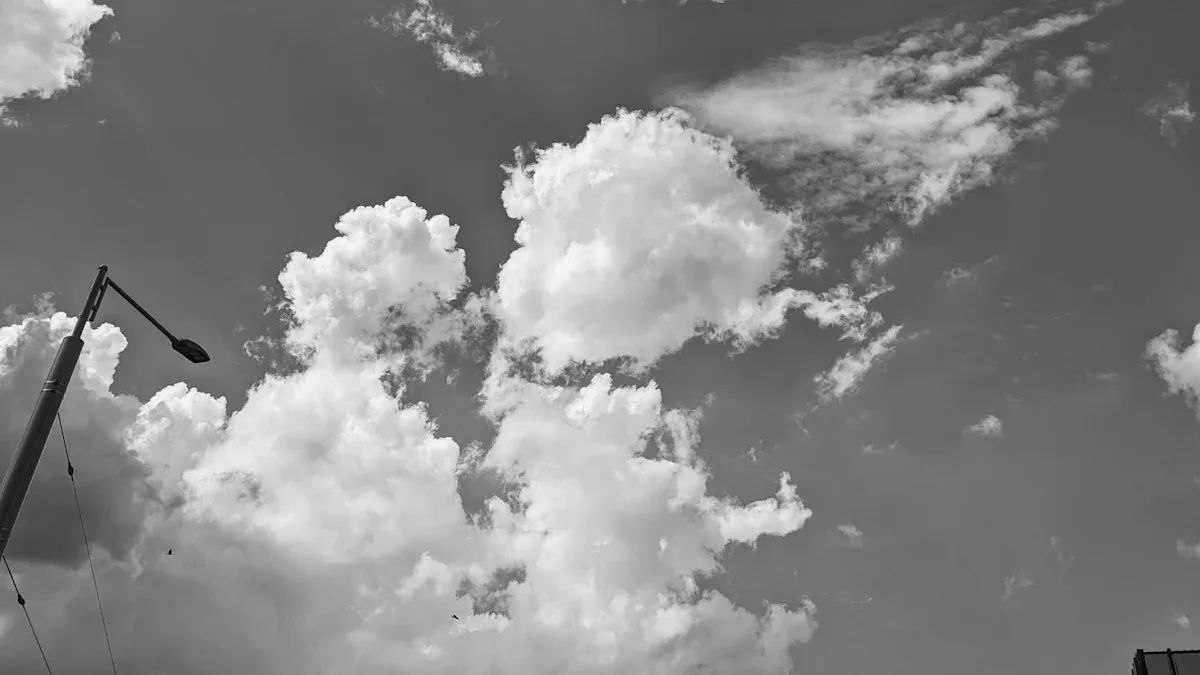
Contrast Metrics
Engineers use several metrics to measure contrast in machine vision. The Structural Similarity Index Metric (SSIM) stands out as a popular choice. SSIM breaks down image similarity into three parts: luminance, contrast, and structure. The contrast part of SSIM compares how much the brightness changes between two images. This helps engineers see if image contrast enhancement has made features easier to detect. The Mean Structural Similarity Index (MSSIM) averages SSIM values across different regions of an image. This gives a more complete picture of how well the system can spot features during inspection. These metrics help teams decide if their lighting, optics, and image processing choices have improved contrast enough for reliable inspection.
Enhancement Techniques
Image contrast enhancement plays a key role in making features stand out for inspection. Gamma correction is one of the most effective methods. Recent studies show that optimized gamma correction, such as the World Cup Optimization algorithm, improves image clarity and detail better than older methods like histogram equalization. Gamma correction adapts to different lighting and color conditions, making it suitable for real-time inspection tasks. Another proven technique uses in-pixel processing circuits, which boost contrast directly inside the camera sensor. These circuits can increase the Michelson Contrast Ratio by nearly six times. This makes objects easier to see, even when the background is dark or noisy. Engineers also use adaptive algorithms to adjust contrast for each inspection scene, ensuring that color differences and edges remain clear.
Tip: Choosing the right image contrast enhancement technique depends on the inspection environment, the type of object, and the color properties of the features.
Practical Limits
Engineers face several limits when increasing contrast for inspection. Lighting remains the most important factor. Many teams struggle to design effective lighting because optical physics can be complex. Reliable contrast requires careful planning of both the feature and its background. Sometimes, the first lighting setup does not create enough contrast, so engineers need backup plans. Testing the camera, lens, and lighting with real sample parts helps ensure that contrast stays strong, even when parts move or rotate. Unwanted effects like glare, glints, or shadows can reduce contrast and hide important color details. Teams must document their setups and refine them over time. Even small changes between test and production setups can affect image contrast enhancement and inspection accuracy. These limits mean that every part of the system—from lighting to image processing—must work together to deliver consistent results.
Note: Careful system design and thorough testing help engineers overcome practical limits and achieve reliable inspection with strong contrast and clear color separation.
Challenges and Solutions
Low Contrast Issues
Low contrast often creates major obstacles in machine vision inspection. Several factors contribute to this problem:
- Suboptimal lighting techniques, such as improper use of backlighting or dark field lighting, can reduce the visibility of features.
- Inappropriate light wavelength and frequency make it difficult to distinguish between similar color surfaces, especially when contaminants like oil are present.
- Environmental noise, including background and overhead lighting, interferes with image clarity.
- Electrical noise in industrial environments further degrades image quality.
These issues occur frequently in industrial inspection settings, where conditions are rarely stable. To address low contrast, engineers optimize lighting techniques, calibrate sensors, and select the best color wavelengths for each inspection task. Advanced image enhancement models, such as Transformer-based architectures, also improve detection accuracy in low-light and low-contrast environments. These models focus on key objects, making feature extraction more robust during inspection.
Environmental Factors
Environmental factors can significantly impact image contrast and inspection reliability. Machine vision systems depend on high-intensity lighting to reveal surface anomalies and color differences. Variations in ambient light, temperature changes, and dust can degrade image quality by reducing contrast and causing inconsistent illumination. Dust and moisture may enter lighting enclosures, leading to contamination or fogging that lowers contrast and hides color features. To maintain stable lighting, engineers use rated enclosures, ruggedized lights, and techniques like active cooling or internal heating. Proper enclosure venting and strategic light positioning help preserve consistent illumination, ensuring accurate inspection and reliable color detection.
Balancing Contrast and Resolution
Engineers must balance contrast and spatial resolution to achieve optimal inspection results. The Modulation Transfer Function (MTF) of the lens and sensor determines how well the system maintains contrast at different detail levels. As spatial frequency increases, finer details appear with lower contrast. Adjusting the lens aperture affects both diffraction and aberrations, which can reduce sharpness and color clarity. Sensor pixel size and the Nyquist frequency limit the maximum detail that can be captured without losing contrast or introducing artifacts. A well-matched system balances lens and sensor performance, ensuring that inspection tasks capture both high contrast and fine color details. Illumination quality, digitization bit depth, and image processing software also influence the trade-off between contrast and resolution. Design guidelines recommend maintaining about 30% contrast at two-thirds of the sensor’s Nyquist frequency for balanced inspection performance.
Tip: Engineers should test lighting, optics, and sensor settings together to find the best balance between contrast and resolution for each color inspection application.
Image contrast remains essential for reliable inspection in machine vision systems. Lighting, optics, sensor, and image processing each play a unique role in making color features clear and easy to detect. Teams that optimize all four cornerstones see better inspection results, with lighting alone improving defect detection rates by up to 30%. Proper exposure control prevents over- or under-exposed images, which can hide color details and cause inspection errors. High-quality sensors and advanced algorithms help capture every color difference, supporting accurate inspection in any environment. By focusing on contrast, engineers ensure that color features stand out, making every inspection more effective.
- Lighting, optics, sensor, and image processing work together to reveal color features.
- Optimized systems deliver consistent inspection results and reduce errors caused by poor color contrast.
Teams should always prioritize contrast optimization for the most accurate and efficient inspection outcomes.
FAQ
What is the main reason image contrast matters in machine vision?
Image contrast helps the system see differences between objects and backgrounds. High contrast makes features stand out. This leads to better detection, measurement, and inspection results.
How can lighting improve image contrast?
Proper lighting highlights important features and reduces shadows or glare. Engineers choose lighting types, such as backlighting or diffuse lighting, to make objects easier to see. Good lighting increases inspection accuracy.
Do sensors affect image contrast?
Yes. Sensors with high dynamic range capture both bright and dark areas well. Larger pixels collect more light, which improves contrast. Sensor choice impacts how clearly the system sees features.
Can image processing fix poor contrast?
Image processing can enhance contrast using algorithms like histogram equalization. However, it cannot fully correct problems caused by poor lighting or optics. Teams should optimize all system parts for best results.







